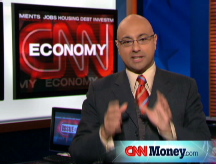Inflation: 3 big questions
Uncle Sam says the cost of living isn't out of hand. Then why do you feel like you're living hand to mouth?
(Money Magazine) -- Crude oil is trading at $135 a barrel. Global food prices are so high that they've triggered riots in some poor countries. No wonder many sharp-eyed market observers worry that the two-decade stretch of low inflation is coming to an end.
That's hardly certain, but the risk is high enough and immediate enough that you need to confront some serious questions about today's landscape. For most of us, those questions about inflation boil down to these three:
By historical standards, we're still living in a world of manageable price increases. According to the Bureau of Labor Statistics, the official scorekeeper of inflation, the main consumer price index (CPI) is up 4.2% since last May. That's high for this decade, but hardly panic-inducing.
Hang on, though - only 4.2%? Who are they kidding? Does anybody at the BLS ever gas up a car?
"The official data are not jibing with what people are experiencing in their real life," says Barry Ritholtz, CEO of research firm Fusion IQ and a well-known critic of the official inflation measure.
Part of the disconnect is psychological. You buy food and gas, which are skyrocketing in price, much more frequently than, say, digital cameras, which are getting cheaper. So the rising prices loom larger in your mind than the falling ones.
But the truth is that official inflation will unavoidably be a rough approximation, at best, of what you are feeling in your wallet. To build the CPI, the BLS collects price information on thousands of goods and services. Each of those items is part of a hypothetical basket of goods a typical urban consumer might buy.
But, of course, no one is exactly average. For instance, food is about 15% of the household budget in the CPI, but it could be a much bigger chunk of your spending if you have a big family. In that case, your personal CPI may be zooming ahead of the numbers you read in the paper.
And then there's the way the BLS goes about measuring price increases. The biggest component of a typical budget, housing, can't be calculated by measuring home-sale prices. Instead, the BLS uses a figure that estimates the amount homeowners would pay if they rented their homes.
During the height of the housing bubble, that methodology made for a wild disconnect between the price increases home buyers were actually facing and what the CPI measured. Even today, if you buy a house, you are still going to pay significantly more than you would have a few years ago in many markets - a reality not reflected in the CPI.
There's yet another peculiar feature of the inflation formula: The BLS adjusts the numbers to reflect quality improvements. This makes some sense. After all, today's $2,000 laptop is faster and lighter than a $2,000 system from 1998 and can double as a TV, stereo and videoconferencing system. But does the average consumer think a 2008 sedan is actually cheaper than a 2007 model just because the manufacturer improved the tire-pressure monitors?
Critics including Bill Gross, the managing director of bond giant Pimco, argue that such adjustments are just too subjective. But statistical nuances aside, there's one big, obvious reason why 4.2% is more painful than it looks.
"There's been this collision of faster price growth and weaker wage growth," says Jared Bernstein, a senior economist at the Economic Policy Institute. In April, hourly earnings grew by 3.4% over the previous year, less than the CPI. The upshot: You've got cause to be anxious.
"The fears of inflation are not overblown," says Bernstein. "After you factor in inflation, people are facing declining wages."
Inflation could easily go higher from here. To understand why, you first have to know what really drives prices up. To read the newspaper business section these days, the cause of the current spike seems obvious: China.
It's certainly true that in China, as well as the rest of the developing world, low-wage workers are rapidly climbing the economic ladder and consuming more. That's put massive pressure on markets for basic commodities like oil and wheat.
"The problem with both food and energy is that supply is still rushing to catch up with global demand," says economist Ken Beauchemin of Global Insight.
But rising food and fuel prices don't necessarily trigger higher prices across the board - consumers might, for example, just respond to higher gas prices by paying less for cable TV and other stuff. What really determines the overall level of prices is the amount of money sloshing around in the economy.
When there are too many dollars chasing too few goods and services, you get inflation. And it's the Federal Reserve's job to get that balance right. When the Fed lowers rates, it pumps more cash into the economy; when it raises rates, it pulls the money back in.
"When inflation first shows up, people are always wanting to blame other things than Federal Reserve policy," says Brian Wesbury, chief economist at First Trust Advisors. "In the 1970s it was OPEC, today it's China. But in reality, our inflation is coming from easy money."
Actually, inflation without food and energy - so-called core inflation - is still fairly low for now. (That good news, ironically, is partly a result of those stagnant wages.) But there's a solid case to be made that money has been too easy for too long.
In the aftermath of the 2001 stock market collapse and the attacks of 9/11, then Federal Reserve chairman Alan Greenspan embarked on an aggressive interest-rate-cutting campaign to stimulate the economy, culminating in a 45-year-low rate of 1%.
The Fed followed that up with some rate hikes, but new chairman Ben Bernanke and his fellow board members have lately been on a rate-cutting tear. Since last September they've slashed the federal funds rate by 3.25 percentage points in an effort to unfreeze jittery credit markets in the wake of the mortgage debacle. The impact is already being felt: In late May, the Federal Reserve hiked its 2008 inflation projection by a full percentage point.
Could inflation get up to the double-digit levels seen in the '70s and early '80s? Unlikely. Most Fed watchers think today's Fed board will ultimately take a much tougher line on fighting inflation than their Carter-era counterparts did.
"It's nearly impossible for me to believe that we could ever return to double-digit inflation, given the lessons of history," says Beauchemin. Still, the risk of at least some inflation is likely to keep nagging for a while. Even if the Fed stops cutting rates, Wesbury argues, that won't be enough. "We won't whip inflation until we get interest rates much higher than they are today," he says.
The dilemma for Bernanke and company is that higher interest rates tend to slow down economic growth and boost unemployment. With the credit crisis still roiling, the Fed may be more frightened of triggering an economic bust than it is of higher prices.
Inflation is annoying enough in the short term - a fact you're reminded of every time you pour $4-a-gallon milk on your cereal. Over the longer run, it's the mortal enemy of anyone who wants a comfortable retirement.
For instance, assuming today's inflation rate of about 4%, a private pension or annuity payment of $5,000 a month will buy only $2,300 worth of goods and services in 20 years' time. If inflation jumps to 6%, the purchasing power of that retirement income will fall to $1,600 over that same period.
Inflation will also decrease the value of any insurance policy that pays a fixed benefit. That's why financial advisers recommend an inflation rider for long-term-care policies. Even then you generally have to choose in advance the annual rate by which benefits increase; if inflation turns out to be higher, you've lost some protection.
Inflation fears also portend higher interest rates, since they're the Fed's main tool for fighting higher prices and lenders' best way of protecting themselves. So one of the best hedges you have right now is to lock in your debt at today's low rates.
For instance, if you're a homeowner and you have an adjustable-rate mortgage, you couldn't pick a better time to refinance into a 30-year fixed-rate mortgage. Get those 6% rates while they last - because they probably won't.
Last but not least, rising inflation can hammer your portfolio returns, even on low-risk investments like U.S. Treasuries. As interest rates go up, so do the yields that bond issuers must offer to entice new investors. That makes all the investments already in the market less valuable by comparison.
Are you prepared for a financial emergency?
With a recession and rising inflation, it's more crucial than ever to have a six to 12-month living-expense cushion in cash for an emergency. Don't have it? Drop us a line at makeover@moneymail.com. Include your name, age, city, state, marital status, occupation, how much you have in cash savings and retirement savings. Please send a photo of you (and your spouse, where applicable) too. ![]()




